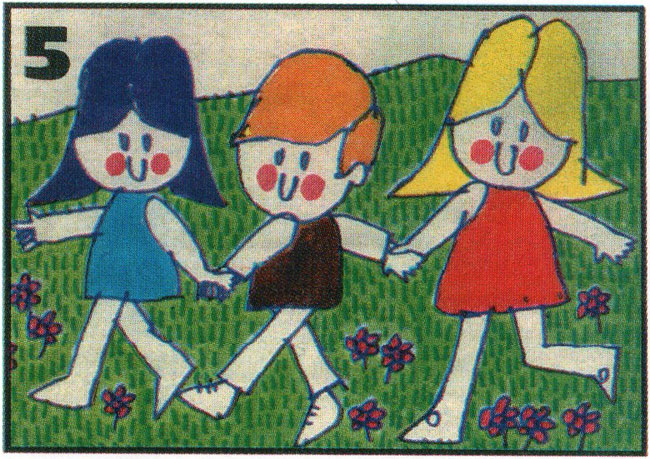Promotional comic strip for the Shell Junior Club (Olidin #23, 1961).
Joop Wiggers was a Dutch graphic artist, lay-out designer, publisher and entrepreneur. He is best-known as the original publisher of Jan Kruis' family comic 'Jan, Jans en de Kinderen', and the initiator of the franchise's merchandising line.
Early life and career
Jozef Frits Eduard Wiggers was born in The Hague in 1937. His father worked at a printing house and from the paper trimmings he brought home, young Joop cut letters so he could explain words and sentences on the floor. A painter who lived next to the Wiggers family noticed Joop's creative talent, and suggested he should attend the drawing academy. Joop accepted the advice and was trained as a graphic designer.
Van Maanen
In the early 1960s, Wiggers worked for the Van Maanen the advertising agency directed by Eddy de Smet, the father of future comic artist Peter de Smet. There, he first met fellow illustrator Jan Kruis, who remained a close associate and friend for the rest of his life. Both Wiggers and Kruis worked on Van Maanen's campaigns for Shell, DAF and Porsche, while they also contributed to Olidin, the magazine of the Shell Junior Club. While Kruis produced comic series like 'Tommy' and 'Baldino', Wiggers did lay-outs and supervised the overall production of the magazine, while also making illustrations. His recurring character was Jantje, the mascot of the Shell Junior Club, who appeared on editorial pages, covers and an occasional promotional comic strip. Other members of the Shell Junior Club were Stientje and Gertje, who appeared in comic strips by Jan Kruis. Further important contributors to Olidin were Emile Brumsteede, Wim Giesbers, Friso Henstra, Niek Hiemstra, Hans G. Kresse, Jan Kruis, Ted Mathijsen, Joost Rietveld, Chris Roodbeen, Jan van der Voo, P. Visser, Dick Vlottes, Carol Voges and Piet Wijn.
Graphic artist
In the mid-1960s, Wiggers decided to leave the advertising agency and continue as a freelancer. In that capacity, he designed campaigns, illustrated children's pages for magazines and produced posters for children, printed by himself. Showing a keen eye for business, Wiggers self-published posters, board games and children's booklets, such as the 'Putsj' series. In 1971, his posters were awarded "Prix l'Européen de Faon d'Or', which he received from Princess Grace from Monaco. During his freelance years, Wiggers continued to collaborate with Jan Kruis. One of their joint productions was Goed Gekleed (1967), an advertising magazine for a purchasing association for expensive men's fashion stores.
Part of a 'Putsj' poster by Joop Wiggers (1970).
Jan, Jans en de Kinderen
On 12 December 1970, Jan Kruis began his popular 'Jan, Jans en de Kinderen' gag page in the women's weekly Libelle. At the time, the magazine's publisher De Spaarnestad was in the middle of a reorganization, and refused to launch a book collection. Still keen on seeing his series released in book format, the artist approached his friend Joop Wiggers, who was all for the project right away. Over a chat in the pub, Kruis gave Wiggers the publishing rights of his strip. Without any formal agreement, a bestselling comic book series was born. To fund the first album of 'Jan, Jans en de Kinderen', Wiggers took out a mortgage on his house. The series was published in a print run of 30,000 copies by Joop Wiggers Producties B.V. in 1972 and was an instant hit. Until 1998, twenty-four additional albums and a host of commissioned publications were produced by Wiggers Produkties. At the height of their collaboration, Wiggers published 150,000 copies per album.
Jan Kruis and Joop Wiggers compiling the 'Jan Kruis' career overview book in 1995.
For thirty years, Wiggers and his wife Beppie served as Kruis' "commercial right hands" and agents. Wiggers saw the commercial possibilities of the fictional Tromp family and initiated a wide range of merchandising. Towels, teapots, canisters, watches, T-shirts, eiderdowns, posters, socks, placemats, service, puzzles, perfumed toilet calendars and other items saw the light. The merchandising especially propelled the family's big red cat into an instantly recognizable mascot. Since Jan Kruis came from the advertising industry himself, he had no issues with the commercial exploitation of his creations. On the occasion of the comic's twentieth anniversary, Wiggers initiated a CD/audio cassette with songs related to the series. The lyrics were written by Jan Kruis and Willem Wilmink, while Harry Bannink composed the music. In the mid-1980s, an animated TV spin-off was made with Wiggers as producer and Wouter Stips as director. In 1985 and 1986, twenty episodes were broadcast by TROS. Two additional prototypes for an animated series were made with animator Gene Deitch, but these projects were canceled. In 1998, the Dutch postal services released a series of 'Jan, Jans en de Kinderen' stamps. Between 1992 and 1999, Wiggers also published eight albums of 'Vijftien en een 1/2', the comic strip made for Margriet mgazine by Jan's daughter Andrea Kruis.
Final years and death
In late 1998, Kruis announced his retirement and sold the rights to his characters to Libelle publisher VNU (whose assets were later acquired by Sanoma and then DPG Media). The production of the comic was transferred to Libelle's editorial offices in Hoofddorp under direction of Wiggers' former assistant Mariken Swildens, while VNU also acquired the rights to publish the books. Although this transfer marked the end of a collaboration of nearly thirty years, Jan Kruis and Joop Wiggers remained close friends.
In his spare time, Wiggers was active as a painter and collector of fashion jewelry. In the late 1990s, Joop and Beppie Wiggers moved from Breukelen to Antwerp, Belgium. In 2016, a large part of their fashion jewelry collection was acquired by the CODA Museum in Apeldoorn. Joop Wiggers passed away on 28 January 2017, coincidentally little over a week after the death of Jan Kruis.








